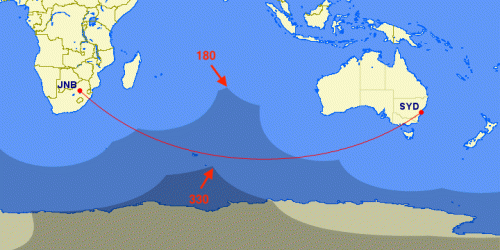Technical question: Why would an inoperable APU cause the aircraft to be ETOPS-incapable?
Sorry
@jb747 - could you explain it again for the non-expert as I am generally curious.
Is it APU issue —> non-ETOPS capable —> ADL runway was closed —> only option remaining was this weird path?
I guess we really need to start with a bit of history. When twins first appeared as major components of air travel, the airlines, of course, wanted to send them everywhere. The regulators were rather more cautious, and the entire concept of extended range twin engine operations appeared. There are all sorts of distance and time limitations within the aviation world, and basically pre ETOPs twins were restricted to being no more than one hour of flight time, at a single engine speed from an airport that they could use. As time went by, the reliability of engines improved, to the extent that engine shutdowns in the cruise are extremely rare. Note that failures on takeoff, climb and descent, are not considered...only cruise. So that led us to the push for longer ETOPs, with 90 minute, 120 minute, 180 and 317 minute approvals. And so on probably... The idea of 317 minutes, engine out is not all that appealing to me.
The engines provide more than just thrust though. That's where we get hydraulics, and electrical power, and air for the pressurisation system. If you lose an engine, you probably lose half of your ancillary systems as well. And that's where the APU comes in. They can provide electrical power and pneumatic air, and hydraulics indirectly via either an electric or air driven pump. That leaves us with an aircraft on one engine, but with most other systems intact.
But, it was also realised that whilst engines might be extremely reliable, other systems might not. Starting with the APU itself. Firstly no APU, no ETOPs, but in some cases that APU might have to be started before reaching the ETOPS area, and kept running the entire time. On aircraft like the 747 the APU can't be started in flight, and was only ever used on the ground and for some take offs. The 380's could be started in flight, but not guaranteed at altitude, and its use was largely to give back full electrics after an engine failure, thus allowing Cat III. The 767, being a twin had an unrestricted APU (and I expect the 330 is the same). Beyond that though there are other systems that can make operating the aircraft difficult. For instance; autopilots. They're required in most airspace, but trying to fly without one is very tiring in the long term.
Thinking about this PRIM (and I'll post the entire MEL so you can read and confuse yourselves). Whilst it's a primary flight control computer, it's one of three. Loss of one has very little effect, other than on redundancy. Sometimes specific computers have functions locked to one system, but in the case of PRIMs, they're mostly interchangeable. The black boxes themselves are identical. The 330 also has a couple of SECs (which predictably are secondary computers). Best to think of them as falling further down the chain of redundancy, though normally SECs have no function if the PRIMs are operating. As an aside the 380 had 3 PRIMs and 3 SECs. All six were identical black boxes, but once installed the SECs did not have the same functionality as a PRIM. Any one computer can fly the aircraft, but it would be very limited.
So, with PRIM 1 out of the system, what is the issue, given that almost all functions will operate normally? The biggest problem that immediately comes to mind is that you're very near to a flight control law reversion. If, for example, the heater that provides anti icing to the #2 sideslip probe were to fail, then the #2 PRIM would consider that to be invalid data, and without #1 to provide another source, the system would probably consider #2 to be suspect and so would force a law reversion, probably to alternate law (but possibly even direct). Now, you've lost all of your autopilots, and the aircraft is much harder to fly accurately than normal. You don't need something as obviously important as a flight control computer for this sort of thing to happen though. An issue with an air data computer plus any probe from another system (i.e. #1 & #3) could cause the same sort of reversion.
Because the relationships between systems might not be all that apparent, we end up with the manufacturers generating a huge list of faults and limitations (MELs). They govern what the engineers can sign out as being acceptable. Basically, if it doesn't have an MEL, then it must be fixed. MELs might provide limitations (i.e. no ETOPS), changes to coughpit procedures and calculations, engineering procedures, and they all come with time limits. They can also be quite complex and take time to work though.







